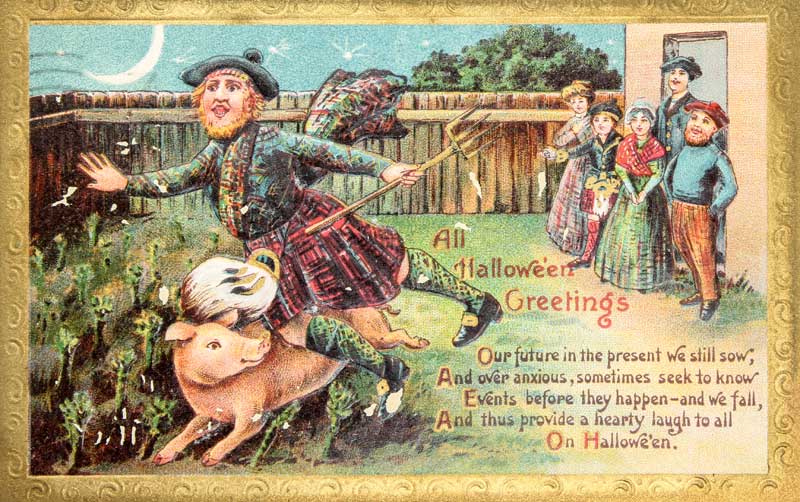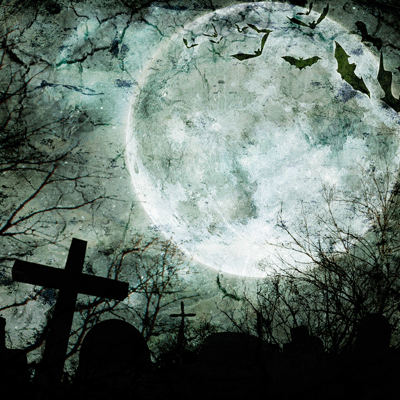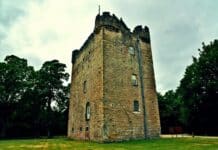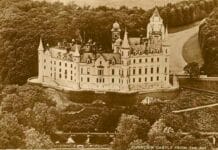MJ STEEL COLLINS looks at the very Scottish tradition of Halloween

Dressing up, trick or treating and carving pumpkins are so familiar at Hallowe’en, most probably take them for granted. Digging around their origins reveals a very Scottish and slightly macabre picture.
The term Hallowe’en itself has Scottish origins, being a shortened version of the term “Allhallow-even”, meaning All Hallows Eve, the day before All Saints Day, November 1st.
The term itself is Christian and dates from 1745, but Hallowe’en dates back to the ancient celebration of Samhain (pronounced “Sow-wen).
What is Samhain?
In the pre-Christian world, the Celtic calendar was decided by the seasons.
Samhain, the end of the summer and harvest time, marked the end of the year.
It was also regarded as a feast for the dead and a time when evil spirits were believed to walk abroad.
Bonfires were lit in villages to keep spirits away and in houses, fires were extinguished and relit from the bonfire.
As Christianity took over from the old ways, Samhain was integrated into the Christian calendar.
Despite this, the old practices continued and it was still believed that the dead came back for a wee daunder among the living.

Extra places were set at dinner in case a spirit dropped by for a quick repast, and food left out as an offering.
The belief that spirits, witches and other evil beings were out to do harm led to protective measures that evolved into the modern practices we know today at Hallowe’en.
People would dress up to disguise themselves against evil spirits, and not many ventured out on the 31st for fear of being attacked.
Children dressed up as bogles to similarly disguise themselves. If they were brave enough to be taken out visiting, they would be given a gift at the house they visited as a means of warding off evil.
Halloween traditions in Scotland
In Scotland, this became known as Guising, morphing into the modern Trick or Treat, where children are expected to perform as well as dress up to receive a treat.
In a roundabout way, the practice of guising taken over by Scottish emigrants to the USA, has led to the practice being known by its American terminology in the UK.
Another old Scottish practice, similar to guising, was “Souling”, and was carried out in the Middle Ages. This involved the poor and children going from door to door singing and offering prayers for the souls of the dead in return for food.
The carving of pumpkin lanterns is an American adaptation of the Scots practice of carving turnip lanterns, which has beamed back across the Atlantic.
Turnips not Pumpkins!
Carving pumpkins is a relatively recent phenomenon in the UK; I can remember turnips being carved into a variety of evil grimaces when I was very young in the 1980s.
Whether pumpkin or turnip, the method is much the same.
The innards of said food item are scooped out, and a face carved into the skin on the outside. A candle is then sat inside to light up the menacing visage.
The manufacture of these lanterns stems back to another old protective custom. This one consisted of the placing of skulls on poles outside a settlement to keep evil spirits at bay.
Other old protective measures that haven’t quite made it to the modern celebration of Hallowe’en include the sprinkling of salt or urine around the threshold of a building.
Evil entities could also be warded off by carrying firebrands and hanging holly or rowan branches from lintels in homes, barns and stables. In earlier times, crops and animals, as well as people, had to be protected from perceived evil witches, spirits and fairies roaming at Hallowe’en. Bonfires continued to be burned to deter witches, though today they have shifted over to Guy Fawkes Night.
Dooking for apples
A rather popular Hallowe’en game played in Scotland, which has also travelled to the States, is dooking for apples.
This involves pouring a quantity of apples into a basin of water.
Participants then attempt to win an apple by either spearing it with a fork or grabbing it with their teeth.

The latter was preferred by my cousins, but one I think that had me in tears as a kid, so the fork was brought out!
Dooking for apples is thought to come from the festival celebrating Pomona, the Roman Goddess of fruit, although apparently some experts are dubious. The festival was held at the same time as Samhain, the two eventually merging.
Looking for love on Halloween
One was a take on dooking for apples. This involved grabbing an apple by mouth, skinning it in one long peel, passing the peel ‘sun wise’ three times, before throwing it over the shoulder.
The shape of the landed peel revealed the initial of a future lover’s name. Engaged couples, in another game, would put a nut on the fire. If the nut burned quietly, it signified a happy marriage but if the nut sparked and hissed, the marriage would be unhappy.
Alternatively, a pair of lovers would put a nut each on the fire, and how the nuts burned predicted the future success or failure of the relationship. Again, a quietly burning nut was good, whilst a sizzling nut not so. Another game involved pulling kale stocks out the ground. They would indicate the shape and size of a future lover, whilst any dirt left on the root indicated wealth.
If anything, how Hallowe’en is celebrated today just shows how pervasive traditions can be, even if they do wind up with a slightly American and commercial flavour.
Of course, you could always counter this with some skulls on sticks in your front garden, rather than pumpkin lanterns!
EXTRA: Aberdeen newspaper laments the decline of Scottish Halloween during the 1930s
Here’s an old article from 1934, lamenting the decline of Halloween…
Halloween is coming soon and we’re getting very excited. It won’t be long until those of us who passionate about the night and things that bump in it, can openly celebrate the darkness.
But it hasn’t always been that way. We recently found this article from the Aberdeen Journal (Wednesday, 31 October 1934) lamenting the decline in Halloween. Thankfully Halloween is as strong as ever, but it’s worth reading this writer’s call to celebrate Halloween as a British institution…
“Halloween. Time was when this day was the greatest social festival of the Scottish year.
Halloween and its innocent amusements for generations provided poets and prose-writers – the former often indistinguishable from the latter – with themes for their lucubrations; and certainly did most heartily entertain those who participated in it.
But time was and time is, as the old play had it; and what was is different from what is.
The venerable and natural Halloween has gone.
It could not possibly remain.
It belonged to pastoral and humble civilisation, versed in ancient tradition, possessed of scanty leisure and material wealth, but still full enough of the simple joys of life to be ready and able to take advantage of a good opportunity for indulging in Hence came the popularity of Halloween, of Yule, and of Beltane.
To-day our civilisation is urban and complicated; leisure is abundant and distractions are infinitely various; and so Halloween has come to be regarded as tiresome and silly and to be forgotten when we “put “away childish things”.
A few clubs and associations, a few remote communities, may still celebrate the great evening with all its time-honoured rites, but the revival gives the impression of being little artificial —as if we were for a few hours reverting to Kilmarnock bonnets and cruisies, “nappy” ale and all the other externals life in Scotland two centuries ago.
It is a-great pity that Halloween should have become an anachronism, but it was bound to follow the stagecoach and the plough-ox.”








Another Scottish Hallowe’en game involved hanging up scones on a string, and covering them with black treacle. Children had then to try and eat the scones without using their hands. The American version of Hallowe’en which has been imported into England in the last 20 years is very commercialised, and has an unpleasant accent on zombies and bodily decay. The old Hallowe’en in Scotland was a gentler festival, more to do with spooks,
Couldn’t agree more, money money money that’s all it seems to be about now, back in the sixties i can remember at Halloween Dumplings filled with tanners (old sixpences) being cooked on the old fireside range, if you managed to receive a piece of the dumpling with the tanner in it it was good luck and of course it was because you got to keep the tanner… happy Halloween days long gone.